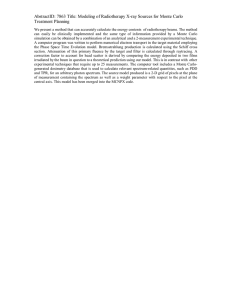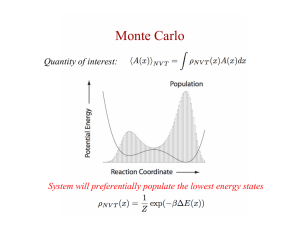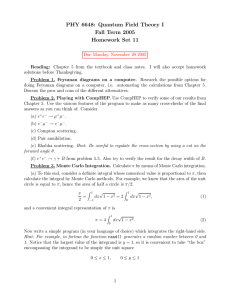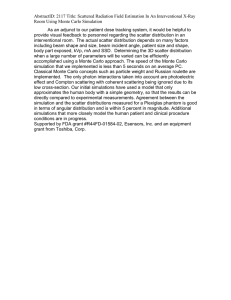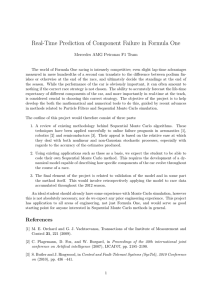Determination of the optical properties of turbid media from a
advertisement
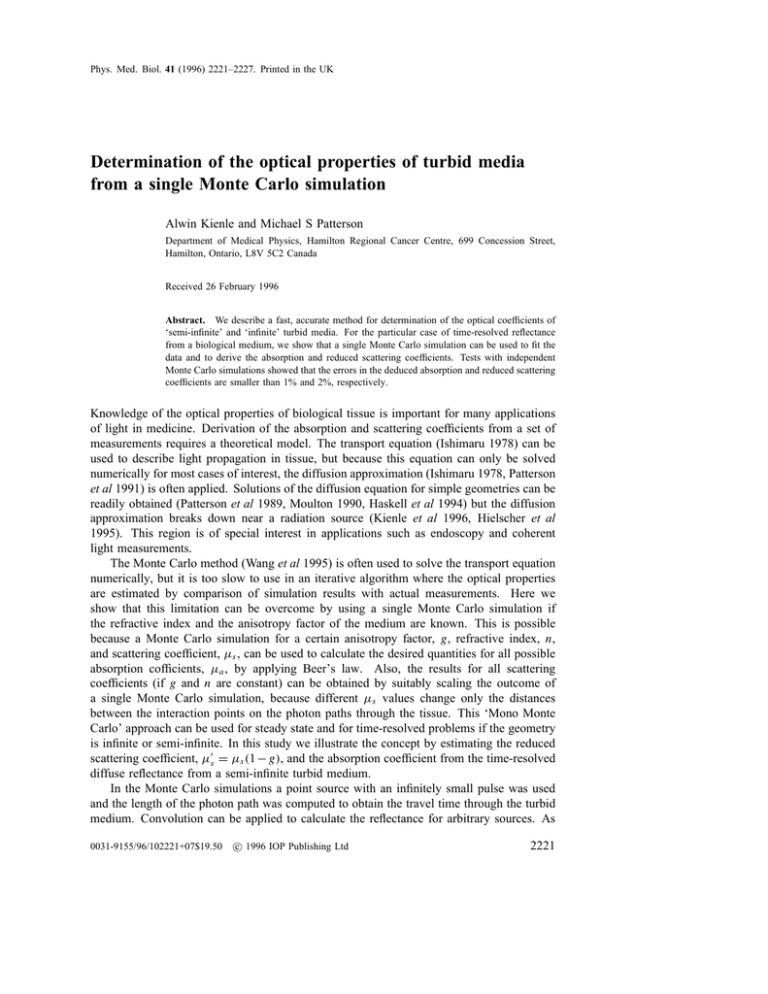
Phys. Med. Biol. 41 (1996) 2221–2227. Printed in the UK Determination of the optical properties of turbid media from a single Monte Carlo simulation Alwin Kienle and Michael S Patterson Department of Medical Physics, Hamilton Regional Cancer Centre, 699 Concession Street, Hamilton, Ontario, L8V 5C2 Canada Received 26 February 1996 Abstract. We describe a fast, accurate method for determination of the optical coefficients of ‘semi-infinite’ and ‘infinite’ turbid media. For the particular case of time-resolved reflectance from a biological medium, we show that a single Monte Carlo simulation can be used to fit the data and to derive the absorption and reduced scattering coefficients. Tests with independent Monte Carlo simulations showed that the errors in the deduced absorption and reduced scattering coefficients are smaller than 1% and 2%, respectively. Knowledge of the optical properties of biological tissue is important for many applications of light in medicine. Derivation of the absorption and scattering coefficients from a set of measurements requires a theoretical model. The transport equation (Ishimaru 1978) can be used to describe light propagation in tissue, but because this equation can only be solved numerically for most cases of interest, the diffusion approximation (Ishimaru 1978, Patterson et al 1991) is often applied. Solutions of the diffusion equation for simple geometries can be readily obtained (Patterson et al 1989, Moulton 1990, Haskell et al 1994) but the diffusion approximation breaks down near a radiation source (Kienle et al 1996, Hielscher et al 1995). This region is of special interest in applications such as endoscopy and coherent light measurements. The Monte Carlo method (Wang et al 1995) is often used to solve the transport equation numerically, but it is too slow to use in an iterative algorithm where the optical properties are estimated by comparison of simulation results with actual measurements. Here we show that this limitation can be overcome by using a single Monte Carlo simulation if the refractive index and the anisotropy factor of the medium are known. This is possible because a Monte Carlo simulation for a certain anisotropy factor, g, refractive index, n, and scattering coefficient, µs , can be used to calculate the desired quantities for all possible absorption cofficients, µa , by applying Beer’s law. Also, the results for all scattering coefficients (if g and n are constant) can be obtained by suitably scaling the outcome of a single Monte Carlo simulation, because different µs values change only the distances between the interaction points on the photon paths through the tissue. This ‘Mono Monte Carlo’ approach can be used for steady state and for time-resolved problems if the geometry is infinite or semi-infinite. In this study we illustrate the concept by estimating the reduced scattering coefficient, µ0s = µs (1 − g), and the absorption coefficient from the time-resolved diffuse reflectance from a semi-infinite turbid medium. In the Monte Carlo simulations a point source with an infinitely small pulse was used and the length of the photon path was computed to obtain the travel time through the turbid medium. Convolution can be applied to calculate the reflectance for arbitrary sources. As c 1996 IOP Publishing Ltd 0031-9155/96/102221+07$19.50 2221 2222 A Kienle and M S Patterson phase-function the Henyey-Greenstein function (Henyey and Greenstein 1941) was used. (We simulated a slab with a thickness of 30 m. Thus, the probability that a photon reached the lower boundary equaled zero and the geometry could be considered as semi-infinite.) First we demonstrate that different anisotropy factors do not significantly influence the time-resolved reflectance if g is close to 1, as is the case for tissue, so that the results of a single simulation can be used. In general the solution to the transport equation depends on four different optical parameters n, g, µs and µa . The refractive index, n, is about 1.4 for all soft tissue (Bolin et al 1989). The number of unknown optical coefficients can be further reduced if the principle of similarity is valid. This principle states that different combinations of g and µs yield similar results for dependent quantities such as diffuse reflectance. The simplest relationship is that conservation of (1 − g)µs will ensure similarity. We performed Monte Carlo simulations of time-resolved reflectance, R(t), for different optical parameters and radial distances, ρ, from the source to investigate the validity of this relationship. Figure 1 shows R(t) for µ0s = 1 mm−1 and µa = 0 mm−1 at ρ = 2.25, 3.25 and 4.75 mm for g = 0, 0.5, 0.8 and 0.9. This figure, and calculations with other sets of optical coefficients, shows that the simple similarity relation is valid for g > 0.8. Because the anisotropy factor of tissue is normally greater than 0.8 (Cheong et al 1990) and Monte Carlo calculations are faster for smaller g, g = 0.8 was applied in the Monte Carlo simulations in this study. Figure 1. Time-resolved diffuse reflectance for different anisotropy factors, g = 0 (long dashed curve), g = 0.5 (dashed), g = 0.8 (circles) and g = 0.9 (solid), at distances ρ = 2.25, 3.25 and 4.75 mm. The other optical properties are µ0s = 1 mm−1 , µa = 0 mm−1 and n = 1.4. Determination of the optical properties of a semi-infinite or infinite turbid medium with a single Monte Carlo simulation is based on the following principle: it is possible to extract from the output of one simulation, performed with certain optical parameters, the desired quantities for other optical coefficients if the anisotropy factor is the same (or the similarity Optical properties of turbid media 2223 relation is valid) and the refractive index does not change. From the results of a Monte Carlo simulation performed with certain reference parameters, µsr and µar , the desired quantity, such as the diffuse reflectance, can be obtained for µsr and any absorption coefficient µa using Beer’s law. For example, if µar = 0, the time-resolved diffuse reflectance, R(ρ, t), can be calculated for any µa from the reference time-resolved reflectance Rr (ρ, t) by R(ρ, t) = Rr (ρ, t) exp (−µa c t) (1) where c is the speed of light in the turbid medium. For the case µar = 0, the results of the single Monte Carlo simulation can also be scaled to yield the desired quantities for any scattering coefficient. This is because altering the scattering coefficient in the simulation results only in different lengths of the photon paths through the tissue (Graaff et al 1993). In the case of time-resolved reflectance this means that R(ρ, t), for arbitrary µs and µa = 0, can be derived from Rr (ρ, t) calculated for µsr and µar = 0 using µs µs µs 3 Rr ρ ,t . (2) R(ρ, t) = µsr µsr µsr The scaling factor for the distance variable is due to the different path lengths of the photons, and consequently the time variable has to be scaled by the same value. A factor (µs /µsr )2 (before Rr ) stems from the scaling of the area and the remaining factor (µs /µsr ) from the scaling of the time. In principle, using equation (1) and equation (2), R(ρ, t) can be easily and quickly calculated for any absorption and scattering coefficients. However, it is not possible to calculate Rr (ρ, t) with Monte Carlo simulations for continuous ρ and t values, but only for certain distance and time intervals, Rr (ρi , ti ), centered at ρi and ti . As a consequence, the results of the reference Monte Carlo simulation have to be interpolated to compute R(ρ, t) with equation (2). In this study a Monte Carlo simulation for µ0s = 1 mm−1 , g = 0.8 and µa = 0 mm−1 was performed, and Rr (ρi , ti ) was recorded for distances between ρ1 = 0.25 mm and ρ40 = 19.75 mm at intervals of 0.5 mm, and for times between t1 = 1.25 ps and t40 = 98.75 ps at intervals of 2.5 ps, and between t41 = 105 ps and t230 = 1995 ps at intervals of 10 ps. 33 million photon histories were used to achieve good statistics. A non-linear regression method was applied to estimate the optical coefficients from time-resolved reflectance data using the Mono Monte Carlo approach. Because it is difficult in practice to make absolute measurements of the time-resolved reflectance, we fitted relative data. Thus, not only µa and µ0s but also a scaling parameter was fitted. For the non-linear regression, reflectance data up to t = 1 ns were used, and the logarithm of R(t) was fitted. This requires that µ0s < 2 mm−1 , because of the scaling of equation (2) and because the maximum time recorded in the Monte Carlo simulation was 2 ns. In the ρ direction the logarithm of Rr (ρi , ti ) was linearly interpolated. For example, if the ρ-scaling of equation (2) results in ρ 0 = ρµs /µsr with ρk < ρ 0 < ρk+1 , then the time-resolved reflectance, R(ρ 0 , ti ), is calculated from R(ρ 0 , ti ) = exp (1 − h) ln (Rr (ρk , ti )) + h ln (Rr (ρk+1 , ti )) (3) where ρ 0 − ρk . (4) ρk+1 − ρk Usually the time-resolved reflectance is measured at a certain distance, ρ, at different time-values R(ti ). Thus, for each iteration of the non-linear regression the reflectance must be evaluated at these times requiring interpolation of the reflectance data produced by the Mono Monte Carlo. Initially we used a linear interpolation of ln (R(ti )) between h= 2224 A Kienle and M S Patterson the adjacent time values, but this resulted in optical coefficients which were in many cases incorrect and which depended on the initial estimates for the non-linear regression. Linear interpolation failed because of statistical noise in the Monte Carlo data and rapid changes in the reflectance at short times and small distances. Algorithms such as polynomial interpolation or cubic spline interpolation provided only marginal improvement. In order to improve the interpolation in time we sought an arbitrary function to approximate the R(t) curves of the Monte Carlo simulation. Equation (5) provided a good fit to the logarithm of the time-resolved reflectance for all ρ values: ln(R(t)) = c0 + c1 ln t + c2 (ln t)2 ... + c10 (ln t)10 . (5) The time-resolved reflectance data for all 40 distances were fitted to equation (5) and the fitting parameters, c0 , ..., c10 at each distance were stored for later application. Figure 2. Regression (solid curve) to a Monte Carlo simulation (circles) using equation (5). The parameters of the simulation are µ0s = 1 mm−1 , µa = 0 mm−1 , n = 1.4, g = 0.8 and ρ = 9.75 mm. Figure 2 shows one comparison of the Monte Carlo data and the fit generated from equation (5). Using these fitting functions the interpolation errors in the time axis could be minimized and the noisier data at large time values could be smoothed. Accordingly, the non-linear regression performance was greatly improved and delivered the right optical coefficients in most cases when tested with independent Monte Carlo simulations. However, for small distances and small reduced scattering coefficients the derived optical coefficients were still incorrect. This was caused by the larger interpolation errors in the ρ variable (equation (3)) at small ρµ0s , where the second derivative at the maximum value of R(t) and the first derivative at early times are greater. We solved this problem by creating R(t) curves for intermediate distances by fitting ln(Rr (ρi , ti )) for constant ti values between t1 = 1.25 ps and t29 = 73.75 ps to an eighth order polynomial. Between each two adjacent Optical properties of turbid media 2225 R(ρi , t = constant) data points in the above mentioned time region, three new values were deduced from the fitting curves, increasing the number of R(ρ = constant, t) curves from 40 to 157. These 157 curves were then fitted to equation (5) and a subset is shown in Figure 3. (In Figure 3 the reflectance for small distances exceeds 1 mm−2 ns−1 in a certain time region. To calculate the probability that an incident photon is re-emitted the reflectance has to be integrated over a certain time interval and area. Thus, the probability does not exceed unity.) Figure 3. A sample of the 157 fitted time-resolved reflectance curves using equation (5). The parameters of the Monte Carlo simulations are µ0s = 1.0 mm−1 , µa = 0 mm−1 , g = 0.8, n = 1.4 and 1 < ρ < 12.5 mm; the top curve is for ρ = 1 mm, the bottom curve is for ρ = 12.5 mm, and the other curves have been calculated for intervals of 0.125 mm. The performance of the non-linear regression using these fitted curves was excellent even for smaller ρ and µ0s values. Independent Monte Carlo simulations with µ0s = 0.5 mm−1 , 0.72 mm−1 , 1.0 mm−1 and 1.5 mm−1 were performed for the same time values as in the reference simulation to test the non-linear regression. 120 reflectance curves for distances 2.5/µ0s < ρ < 20 mm (ρµ0s < 20) and an absorption coefficient of µa = 0.02 mm−1 were used. The mean error in the derived optical parameters was smaller than 2% for the reduced scattering coefficient and smaller than 1% for the absorption coefficient. The reflectance values at the earliest times (where the reflectance was less than 10% of the peak reflectance) were not included, but enough data before the maximum of the curve were used so that no essential information was lost. The absolute error in the absorption coefficient was found to be independent of the value of the absorption coefficient, resulting in a greater relative error for smaller µa values. In conclusion, a new method was developed to derive the reduced scattering and absorption coefficients of semi-infinite and infinite turbid media. Using the example of time- 2226 A Kienle and M S Patterson resolved reflectance from a semi-infinite medium, we showed that the reduced scattering coefficient and the absorption coefficient could be determined with errors smaller than 2% and 1%, respectively. The performance of the method was good even close to the source (ρ = 2.5/µ0s ) and, in addition, it can be applied for very large absorption coefficients. (Thus, the method works for the diffuse and the non-diffuse limit of photon propagation.) Either of these conditions can invalidate algorithms based on approximate solutions to the transport equation, such as diffusion theory. However, one has to pay particular attention to potential interpolation errors in the scaling of the reference Monte Carlo data. Once the reference simulation has been performed and the parameters of the regressions of the timeresolved data to equation (5) have been stored, the optical coefficients can be determined from time-resolved reflectance data in approximately one second with a state-of-the-art personal computer. We note that if the Mono Monte Carlo method is used to determine the optical coefficients from steady-state reflectance from a semi-infinite medium (Kienle et al 1996), the interpolation problem is less important because the reflectance curves are smoother and monotonically decreasing with distance. For the simulations an anisotropy factor of g = 0.8 and a refractive index of n = 1.4 were used. We showed that the similarity relation is valid for the high g values found in tissue enabling the use of one anisotropy factor. In order to investigate the influence of a different value of n on the performance of the Mono Monte Carlo method, we performed simulations with n = 1.35 and determined the optical properties using n = 1.4 in the reference simulation. The absorption coefficient could be estimated within 3%, but the error in the reduced scattering coefficient was usually much greater, exceeding 10% for ρ < 10 mm. Therefore, knowledge of the tissue refractive index improves the accuracy of the µa and µ0s estimates. The Mono Monte Carlo method can also be applied in the frequency domain by numerical Fourier transformation of the time-resolved reflectance data at each evaluation of R(t) in the non-linear regression. Acknowledgment This work was supported by the National Institutes of Health grant PO1-CA43892. References Bolin F P, Preuss L E, Taylor R C and Ference R J 1989 Refractive index of some mammalian tissue using a fiber optic cladding method Appl. Opt. 28 2297–303 Cheong W, Prahl S A, Welch A J 1990 A review of the optical properties of biological tissue IEEE J. Quantum Electron. 26 2166–85 Graaff R, Koelink M H, de Mul F F M, Zijlstr W G, Dassel A C M and Aarnoudse J G 1993 Condensed Monte Carlo simulations for the description of light transport Appl. Opt. 32 426–34 Haskell R C, Svaasand L O, Tsay T T, Feng T C, McAdams M and Tromberg B J 1994 Boundary conditions for the diffusion equation in radiative transfer J. Opt. Soc. Am. A 11 2727–41 Henyey L G and Greenstein J L 1941 Diffuse radiation in galaxy Astrophys. J. 93 70–83 Hielscher A H, Jacques S L, Wang L and Tittel F K 1995 The influence of boundary conditions on the accuracy of diffusion theory in time-resolved reflectance spectroscopy of biological tissue Phys. Med. Biol. 40 1957–75 Ishimaru A 1978 Wave Propagation and Scattering in Random Media (New York: Academic) ch. 7, 9 Kienle A, Lilge L, Patterson M S, Hibst R, Steiner R and Wilson B C 1996 Spatially-resolved absolute diffuse reflectance measurements for non-invasive determination of the optical scattering and absorption coefficients of biological tissue Appl. Opt. at press Moulton J D 1990 Diffusion modelling of picosecond laser pulse propagation of turbid media Master’s Dissertation McMaster University, Hamilton, Ontario Optical properties of turbid media 2227 Patterson M S, Chance B and Wilson B C 1989 Time resolved reflectance and transmittance for the noninvasive measurement of tissue optical properties Appl. Opt. 28 2331–6 Patterson M S, Wilson B C and Wyman D R 1991 The propagation of optical radiation in tissue. 1. Models of radiation transport and their application Lasers Med. Sci. 6 155–68 Wang L, Jacques S L and Zheng L 1995 MCML–Monte Carlo modelling of light transport in multi-layered tissues Comput. Methods Prog. Biomed. 47 131–46

